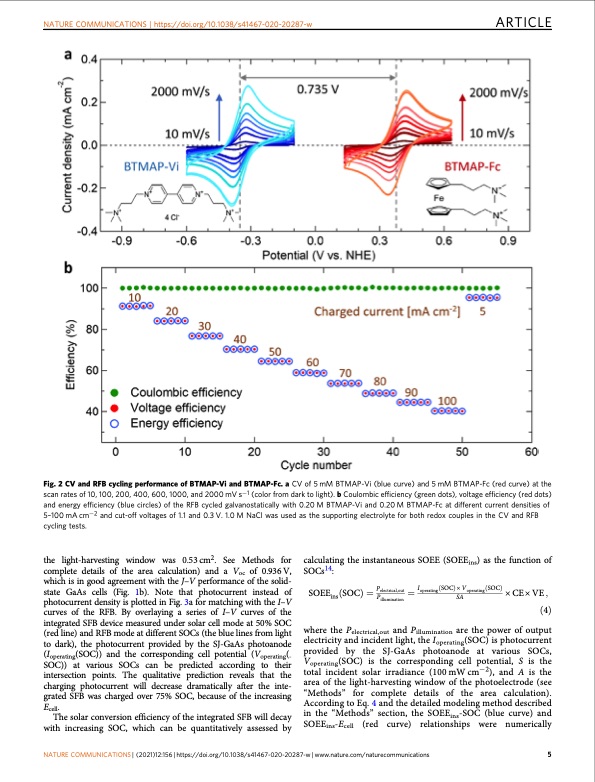
PDF Publication Title:
Text from PDF Page: 005
NATURE COMMUNICATIONS | https://doi.org/10.1038/s41467-020-20287-w ARTICLE Fig. 2 CV and RFB cycling performance of BTMAP-Vi and BTMAP-Fc. a CV of 5 mM BTMAP-Vi (blue curve) and 5 mM BTMAP-Fc (red curve) at the scan rates of 10, 100, 200, 400, 600, 1000, and 2000 mV s−1 (color from dark to light). b Coulombic efficiency (green dots), voltage efficiency (red dots) and energy efficiency (blue circles) of the RFB cycled galvanostatically with 0.20 M BTMAP-Vi and 0.20 M BTMAP-Fc at different current densities of 5–100 mA cm−2 and cut-off voltages of 1.1 and 0.3 V. 1.0 M NaCl was used as the supporting electrolyte for both redox couples in the CV and RFB cycling tests. the light-harvesting window was 0.53 cm2. See Methods for complete details of the area calculation) and a Voc of 0.936V, which is in good agreement with the J–V performance of the solid- state GaAs cells (Fig. 1b). Note that photocurrent instead of photocurrent density is plotted in Fig. 3a for matching with the I–V curves of the RFB. By overlaying a series of I–V curves of the integrated SFB device measured under solar cell mode at 50% SOC (red line) and RFB mode at different SOCs (the blue lines from light to dark), the photocurrent provided by the SJ-GaAs photoanode (Ioperating(SOC)) and the corresponding cell potential (Voperating(- SOC)) at various SOCs can be predicted according to their intersection points. The qualitative prediction reveals that the charging photocurrent will decrease dramatically after the inte- grated SFB was charged over 75% SOC, because of the increasing Ecell. The solar conversion efficiency of the integrated SFB will decay with increasing SOC, which can be quantitatively assessed by calculating the instantaneous SOEE (SOEEins) as the function of SOCs14: SOEE ins ðSOCÞ 1⁄4 Pelectrical;out 1⁄4 IoperatingðSOCÞ ́ VoperatingðSOCÞ ́ CE ́ VE ; Pillumination SA ð4Þ NATURE COMMUNICATIONS | (2021)12:156 | https://doi.org/10.1038/s41467-020-20287-w | www.nature.com/naturecommunications 5 where the Pelectrical,out and Pillumination are the power of output electricity and incident light, the Ioperating(SOC) is photocurrent provided by the SJ-GaAs photoanode at various SOCs, Voperating(SOC) is the corresponding cell potential, S is the total incident solar irradiance (100 mW cm−2), and A is the area of the light-harvesting window of the photoelectrode (see “Methods” for complete details of the area calculation). According to Eq. 4 and the detailed modeling method described in the “Methods” section, the SOEEins-SOC (blue curve) and SOEEins-Ecell (red curve) relationships were numericallyPDF Image | flow battery enabled single-junction GaAs photoelectrode

PDF Search Title:
flow battery enabled single-junction GaAs photoelectrodeOriginal File Name Searched:
s41467-020-20287-w.pdfDIY PDF Search: Google It | Yahoo | Bing
Salgenx Redox Flow Battery Technology: Salt water flow battery technology with low cost and great energy density that can be used for power storage and thermal storage. Let us de-risk your production using our license. Our aqueous flow battery is less cost than Tesla Megapack and available faster. Redox flow battery. No membrane needed like with Vanadium, or Bromine. Salgenx flow battery
| CONTACT TEL: 608-238-6001 Email: greg@salgenx.com | RSS | AMP |